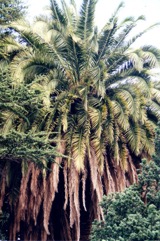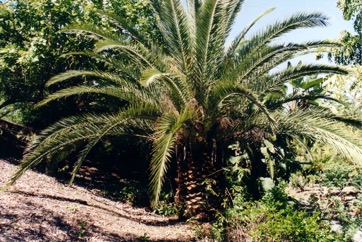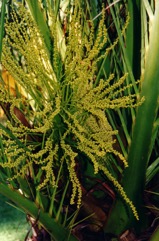Canary Island Date Palm

It is a warm temperate plant. It will tolerate hot dry conditions in inland Australia. It is very frost hardy and thrives on poor soils. It needs good drainage. In the Canary Island it grows to 700 m altitude. In Melbourne Botanical Gardens. In Hobart Botanical gardens. It suits plant hardiness zones 8-11. Arboretum Tasmania.
Also known as:
Kanarska dateljnova palma, Palem korma kannari
Synonyms
- Phoenix cycadifolia Regel
- Phoenix dactylifera var. jubae Webb. & Berthel.
- Phoenix jubae (Webb & Berthel.) Webb ex Christ
- Phoenix vigieri Naudin
- and others
Edible Portion
- Fruit, Sap
Where does Canary Island Date Palm grow?
Found in: Africa, Andes, Argentina, Asia, Australia, Bermuda, Canada, Canary Islands, East Africa, Ecuador, Europe, Greece, Guatemala, India, Indonesia, Mediterranean, North America, Pakistan, SE Asia, Slovenia, South America, Spain, Tasmania
Notes: There are 17 Phoenix species. The seeds contain a fat.
Growing Canary Island Date Palm
Cultivation: Plants are grown from seed. Seed germinates readily. It takes 1-2 months to germinate. In tropical locations suckers can be used.
Edible Uses: The fruit are reported to have an edible outer pericarp. They are a famine food. The sap can be used for syrup or palm honey.
Production: Fruit weigh 1.7 g.
Nutrition Info
per 100g edible portion| Edible Part | Energy (kcal) | Protein (g) | Iron (mg) | Vitamin A (ug) | Vitamin c (mg) | Zinc (mg) | % Water |
|---|---|---|---|---|---|---|---|
| - | - | - | - | - | - |
Canary Island Date Palm Photos



References
Ambasta, S.P. (Ed.), 2000, The Useful Plants of India. CSIR India. p 447
Amoros, A., et al, 2014, Physico-chemical and functional characteristics of date fruits from different Phoenix species (Arecaceae). Fruits, Vol. 69, p. 315-323
Balick, M.J. and Beck, H.T., (Ed.), 1990, Useful palms of the World. A Synoptic Bibliography. Colombia p 662,
Blamey, M and Grey-Wilson, C., 2005, Wild flowers of the Mediterranean. A & C Black London. p 501
Blomberry, A. & Rodd, T., 1982, Palms. An informative practical guide. Angus & Robertson. p 139
Bodkin, F., 1991, Encyclopedia Botanica. Cornstalk publishing, p 787
Cronin, L., 1989, The Concise Australian Flora. Reed. p 229
Cronin, L., 2000, Australian Palms, Ferns, Cycads and Pandans. Cronin Publications. p 64
Cundall, P., (ed.), 2004, Gardening Australia: flora: the gardener's bible. ABC Books. p 1030
Dharani, N., 2002, Field Guide to common Trees & Shrubs of East Africa. Struik. p 292
Facciola, S., 1998, Cornucopia 2: a Source Book of Edible Plants. Kampong Publications, p 30
Gibbons, M., 1993, Palms. Compact study Guide and Identifier. Sandstone. p 60
Gibbons, M., 2003, A pocket guide to Palms. Chartwell Books. p 156
Haynes, J., & McLaughlin, J., 2000, Edible palms and Their Uses. University of Florida Fact sheet MCDE-00-50-1 p 11
http://www.botanic-gardens-ljubljana.com/en/plants
Jones, D.L., 1994, Palms throughout the World. Smithtonian Institution, Washington. p 286
Jones, D.L., 2000, Palms of Australia 3rd edition. Reed/New Holland. p 193
Kermath, B. M., et al, 2014, Food Plants in the Americas: A survey of the domesticated, cultivated and wild plants used for Human food in North, Central and South America and the Caribbean. On line draft. p 641
Krishen P., 2006, Trees of Delhi, A Field Guide. DK Books. p 315
Kunkel,
La Provence Agric. 19:293-297, figs. 66-68. 1882
Lazarides, M. & Hince, B., 1993, Handbook of Economic Plants of Australia, CSIRO. p 187
Lord, E.E., & Willis, J.H., 1999, Shrubs and Trees for Australian gardens. Lothian. p 97
Marcia, M. J., et al, 2011, Palm Uses in Northwestern South America: A Quantitative Review. Bot. Rev. (2011) 77:462-570
Oudejans, J.H.M., 1979, Date palm, in Simmonds, N.W., (ed), Crop Plant Evolution. Longmans. London. p 230
Riffle, R.L. & Craft, P., 2003, An Encyclopedia of Cultivated Palms. Timber Press. p 400
Schuler, S., (Ed.), 1977, Simon & Schuster's Guide to Trees. Simon & Schuster. No. 61
Sukarya, D. G., (Ed.) 2013, 3,500 Plant Species of the Botanic Gardens of Indonesia. LIPI p 800
Tanaka,